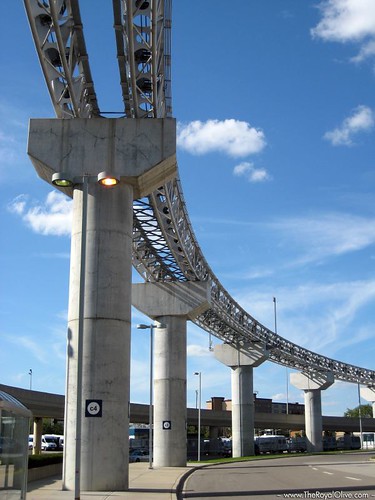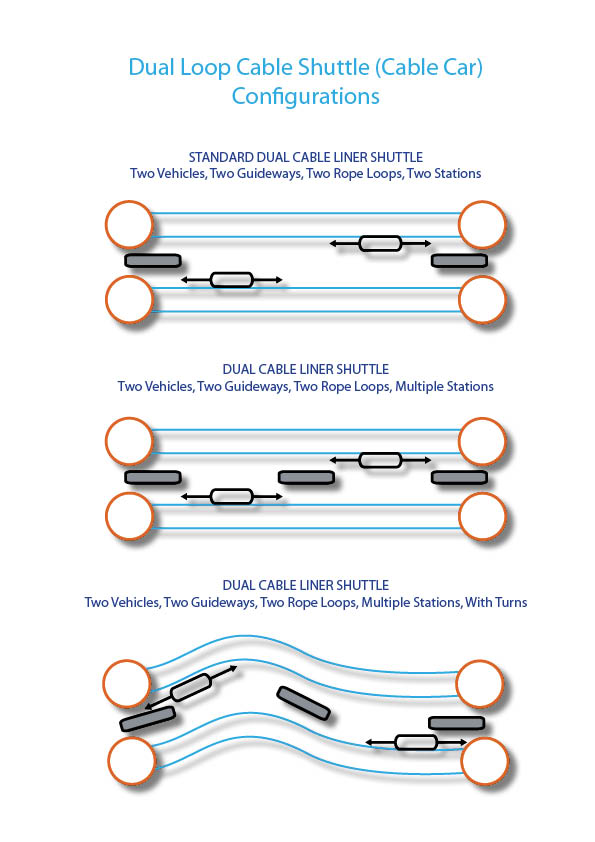
The Pearson Airport Tram in Toronto is an example of a Dual Cable Shuttle LIner. Two tracks and two rope loops allow two separate vehicles to operate independently. Image by flickr user Gustavo Oliveira.
For our new readers: Despite the fact that systems like the planned London Thames Cable Car are often officially called “Cable Cars,” they are more often than not Gondolas. This can be confusing to cable transit novices. To make it easier: Cable Cars are supported from below (like cars) and Gondolas are supported from the top (like ski lift gondolas). This is an error of nomenclature, nothing more.
For Cable Cars Lesson 1, click here.
For Cable Cars Lesson 2, click here.
The Dual Loop Cable Shuttle is a modest upgrade to the Single loop Cable Shuttle. And yet that modest upgrade carriers with it extremely enhanced performance characteristics.
The easiest way to contemplate the performance difference between the two technologies is to imagine the Single Loop Cable Shuttle as an Aerial Tram and a Dual Loop Cable Shuttle as a Funifor.
Like the Funifor-style technologies, the two vehicles in a Dual Loop Cable Shuttle configuration operate independently of one another. This means decreased wait times, increased reliability and the potential for 24 hour service.
For example, the Pearson Airport Tram in Toronto, Canada operates 24 hours a day, 365 days a year in some of the harshest weather any major city on the planet has to experience. And – typical of most Dual Loop systems – it boasts availability levels in excess of 99.5%.
In layman’s’ terms, that means that out of 24 hours a day, 365 days a year the system will operate as expected 99.5% of the time.
The reason for this is rather straightforward: During off-peak hours, there is no reason to have both independent loops running. As such, system operators will take one loop out of service for maintenance, cleaning, etc. while the other loop continues in service.
Similarly, if either of the loops experience an emergency and/or technical problem, the second loop is still available for service. In all but the rarest of circumstances, there will always be one loop available for operation. The vary nature of the system implies built-in operational redundancy.
This redundancy does come with a higher price point than the Single Loop systems (assume for argument’s sake that a Dual Loop system will cost roughly ~150% of the price of a Single Loop system), but the increased reliability it affords makes opting for a Dual Loop over a Single Loop a no-brainer.


10 Comments
Good to see you are back in the educational mode Steven.
Always trying, Sean. Sometimes things have to get pushed back. That post was planned for a couple of weeks ago, but then the Calgary thing hit. One of the challenges of this site is the need to attract people to the site, retain them and convince them that we’re not just a bunch of Zealots yelling “Gondolaaaarrrr!!!” all the time.
I find it necessary, therefore, to balance education, entertainment, personality and link baiting. Education is only one component of what we do. But thanks for the support!
Just for the sake of argument I am going to declare the Toronto APM to be the most technologically advanced form of cable-propelled transit in the world.
I hope there will be a future article about pinched loop systems. Dual loop is just two single loops side by side. Every vehicle has its own exclusive track. Not so with pinched loop systems. Pinched loops have features such as turnouts and trains which can grip one of three cables in stations. With this features any conventional metro line could be build as a cable propelled system
Example Zürich Airport sky metro. Two stations with two tracks each. Two Tracks and three trains a fourth train would be possible. A headshunt after each station and a maintenance track. Total five cable section and three turnouts. Of course the system also can run as a dual loop shuttle. On top of that it has no wheels but rides on air cushions.
That’s the plan, Matthias. There are a couple of issues with pinched loop systems, however, and I’m wrestling with how to best explain the limitations. Sometime in the future.
“Toronto has some of the harshest weather of any major city on the planet…”?
Why is everyone in Edmonton laughing their heads off?
Does Dubai have the hottest summers in the world? No. That distinction would probably go to one of these cities. But that doesn’t mean Dubai isn’t incredibly hot in the summer.
I designed air conditioning for some buildings there. Our design condition was 115F. Of course not many people go there in the summer.
Steven:
Now that they are running dynamic tests on an aerial metro line based on a cable liner running on pinched mode in Caracas, don´t you think that it is about time to describe the pinched loop system in general? Perhaps you could even include some particular technical aspects of the aforementioned system, couldn´t you?
Please, feel free to be as candid, educational, philosophical and entertaining as you have always been. I don’t always agree with what you say but I always enjoy the way you state them and do always learn something from what you write.
Hey, you even survived Caracas traffic!, from what I´ve heard. You should pay a visit, again, and take good pictures, since you have already proven that you are not afraid of going off the beaten track.
Hi Roger,
Sorry for the late reply – I’d love to deal more with that technology, but maintaining the site and work makes it difficult. Hopefully sometime in the near future.